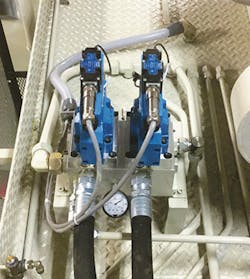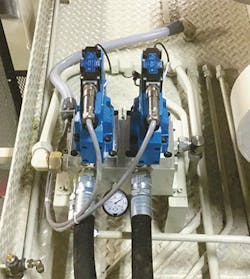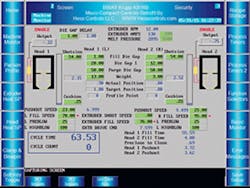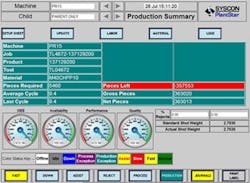Special Report: Universal monitoring, control systems extend old, new capabilities
Monitoring and control systems tailored for a range of plastics processes have gained functionality due to internal developments and through integration with drive packages, third-party software and new technologies.
EUROTHERM ENHANCES FUNCTIONSFOR BLOW MOLDING, EXTRUSION
Blow molders and extruders are asking suppliers of retrofit monitoring and control packages to make available capabilities they have seen on new machines. They also want more functionality for their discrete controls that monitor individual or particular sensors, said Steve Schroeder, business development manager for plastics at Eurotherm by Schneider Electric, Ashburn, Va. Since the purchase of Eurotherm by Schneider Electric a few years ago, Eurotherm has been offering integrated machine control and drive packages that can be added as retrofits.
The company has seen increased demand from blow molders looking to produce different parts on a dual-head accumulator-driven machine. "What is happening is that blow molders with a dual [head] accumulator blow molding unit want their machines to do more than mold multiple versions of the same part in a cycle. Molders are getting more creative, now thinking of molding related parts of a larger component in the same cycle," Schroeder said.
The difficulty of molding two different parts simultaneously is that the parisons can have different dimensions. "The clamp will only close once per cycle. If the parisons don't come down at the same time, closing the mold too soon may result in only half the tool filled with material. If the tool is closed too late, a lengthy parison that extends underneath the mold could result," Schroeder said.
For its MACO Compact control for blow molding, Eurotherm enhanced a shoot-and-fill feature that synchronizes the filling and emptying of the two hydraulically driven accumulators on a dual-head industrial blow molding unit. Schroeder says the feature ensures closed-loop synchronization of the parison heads and accumulators on both sides of the machine, even when different parts and shot sizes are running.
The shoot-and-fill feature monitors and adjusts filling and shooting every 4 milliseconds. The company says that time- and position-based control is used instead of a velocity- or pressure-based control, which allows for large differences between the shooting profiles and strokes for each accumulator head. Enhanced communication through the MACO Compact control allows the machine to fire at different rates, so it can create two different parisons at the same time, Schroeder said.
Another issue in this process is refill synchronization. A multi-head machine process cannot work properly if the heads are not refilled evenly. This requires proportional control synchronization among the heads. That can be accomplished by metering the oil being pushed out of the head cylinder during refill. For this reason, Eurotherm developed a hydraulics package that can be installed on an accumulator blow molding system. It allows older molding units to produce parisons of different sizes. "The system speeds up the parison in one head, but the higher flow is in relation to the other parison. Full clamping on both parisons is the result when parison creation is synchronized," Schroeder said.
Eurotherm's MACO EM3c control for extrusion applications is integrated with Schneider drive packages. Initially targeting extrusion applications, the control retrofit package replaces extruder temperature control enclosure, die temperature control enclosure, HMI enclosure and all drives, including the extruder drive, downstream power drives and winder drives. Eurotherm is currently installing the control and drive package on three extruder lines at the facility of a processor in Wisconsin.
Eurotherm also is updating some of its discrete control technology with a new color display that it says allows more information to be presented in greater detail, said Steve Miller, Eurotherm's sales manager for North America.
Late last year, Eurotherm also rolled out its E+PLC, which pulls in analog and digital data from sensor devices to provide a single point of machine control. Combining digital and analog data on the same device minimizes the number of devices needed to control various machine components. "If you have an extrusion machine with Allen Bradley PLC control and Dynisco-brand pressure indicator and a temperature control from us, we can link all of those items to a network and control all of the components from one PLC. Users get a unified product that offers a single point of control," Miller said.
SYSCON-PLANTSTAR BOLSTERSPRODUCTION MONITORING
Syscon-PlantStar, South Bend, Ind., has enhanced its SnapShot, Portrait and Panorama shop-floor production monitoring and control systems to improve communication with other software platforms or humans. The three systems can be used with a variety of plastics processes.
Late last year, Syscon-PlantStar partnered with DPSI of Greensboro, N.C., a supplier of preventive maintenance software, to combine that company's iMAINT software with Syscon-PlantStar's manufacturing systems. Syscon-PlantStar's systems gather real-time machine data such as total run hours, cycles on a mold and reasons for downtime and passes it to the DPSI system.
DPSI's integrated plant maintenance software uses that data to determine when maintenance is needed, said Syscon-PlantStar VP Gary Benedix. "We use our browser-based operator interface to integrate to the DPSI software. Integrating the software helps a processor better manage tools and machinery parts in inventory," Benedix said. Based on the Syscon-PlantStar data, the DPSI software can generate work orders, when needed. Syscon-PlantStar is a reseller of the DPSI software, said Benedix. A plastics molder placed the second order for the combined system, with the first going to a metal fabricator.
Syscon-PlantStar continues to develop interface communication programs that can connect with proprietary systems from other companies. The company recently developed an interface for the Roboshot line of electric injection molding machines from Milacron, and another interface for the Mold Masters line of hot-runner temperature controls. Syscon-PlantStar also developed a new interface for drying technology manufactured by Dri-Air Industries Inc., Benedix said.
The new interface for the Roboshot machine pulls process data from the electric machine line through its Mold 24i software. The interface for the Mold Masters hot-runner systems provides zone temperature-control data, and from the dryer line from Dri-Air, a molder can pull dew point and temperature information, said Benedix.
"The further development of interface communication protocols is in line with customer requirements to gather more information on their process, not only from the primary equipment but also from secondary devices and auxiliary equipment. Customers more and more are finding a need to monitor new areas in their process or plant in order to tighten control," Benedix said.
Customer demand is leading to new product development for Syscon-PlantStar. "A customer identified process water into and out of the mold as their most critical process variable, but they did not do the best job of monitoring it. So we are working with a supplier to develop snap-on sensors that can tie into the water line to provide real-time temperature and flow rate information," Benedix said.
A Syscon-PlantStar customer, a medical molder, realized that during a certain time of the year insects would hatch inside the warehouse area of the plant, which contained corrugated boxes. The insects could potentially be shipped in the boxes carrying medical devices. The molder placed sensors on the ceiling to measure temperature and humidity. The results were fed back into its PlantStar system.
"Knowing this measurement did not correlate with any aspect of part quality, however, it allowed the molder to predict the potential for insect growth in the corrugated boxes due to high humidity," Benedix said. At the same time, the molder could see that the boxes would absorb moisture during extended periods of high humidity, causing them to collapse. Having the ability to tie the sensor back to the Syscon-PlantStar system gave the molder another point of control.
Benedix said customers are starting to seek out systems for monitoring and controlling assembly tasks. "They want to monitor spin welders and sonic welders to verify how long the equipment takes to heat up, or to record the amperage, or to determine pressures or dwell time," Benedix said.
Syscon-PlantStar has enhanced the way its monitoring systems alert the processor when a machine goes down. Previous versions of this feature would send out an alert to a maintenance person as soon as the machine went down. Now if the maintenance person does not respond in a timely manner, the alert is sent to the plant manager. "If the plant manager is unavailable, the alert is sent further up the chain," Benedix said.
Mikell Knights, senior correspondent
Contact:
Eurotherm by Schneider Electric, 703-724-7300, www.eurotherm.com
Syscon-PlantStar, 574-232-3900, www.plantstar.org



